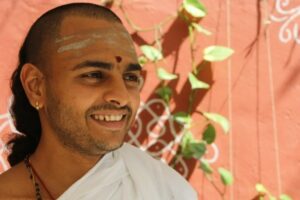Description
To elucidate the fundamental aspects of knowledge, its creation, its process and the method of scientific inquiry. To introduce the Navya Nyaya approach of model building.
₹3,600.00
To elucidate the fundamental aspects of knowledge, its creation, its process and the method of scientific inquiry. To introduce the Navya Nyaya approach of model building.
To elucidate the fundamental aspects of knowledge, its creation, its process and the method of scientific inquiry. To introduce the Navya Nyaya approach of model building.
To elucidate the fundamental aspects of knowledge, its creation, its process and the method of scientific inquiry. To introduce the Navya Nyaya approach of model building.
After the completion of this course, students will be able to
Students of STEM background at high school and UG levels
Scholar Name: Prof. J. Suryanarayana
Email id: suryanarayana.jammalamadaka@mituniversity.edu.in

Shri. J. Suryanarayana aims to groom a new generation who can co-relate the values of Sanatana studies in the contemporary world. His father, Shri. J. B. Sastry instilled in him a love for the study of Sanatana and Adhunatana (modern) disciplines. His traditional education spans Krishna Yajurveda Samhita, Vyakaranam, and Advaita Vedanta. He has successfully completed the Maha Pariksha in Tarka Shastra (Nyaya). He has a rare combination of modern as well as Vedic qualifications and is adept in languages of Samskrit, Telugu, Hindi, English, Tamil, and Japanese. He has won the following awards for his work in Vedic Sciences: Shastra Kalanidhi by Governor, Madhya Pradesh; Tarka Ratnam and Vidwan Mani by HH Sri Jayendra Saraswathi Swami, Head, Kanchi Mutt; and Veda Vidya Varishta by VSR Foundation, Hyderabad. His mainstream qualifications include BA (Samskrit), MA (Samskrit), MA (Nyaya Siromani), and MPhil, PG Diploma in Manuscriptology, and is currently pursuing Doctorate studies. His research works includes critical editing and commentary on ‘sAkshAtkAratva-lakShaNa vichAraH’ as a thesis in University of Madras commentary on ‘kAraka vichAraH’, Sri Venkateswara Vedic University, Tirupati critical editing of ‘Navyamata vichAraH’ and ‘pratibadhya pratibandhaka vichAra’. His diverse experience includes teaching at Sri Venkateswara Veda Paathashala, Hyderabad; He is an adept online tutor including handling NRI students. Proficient at developing good audio-video content, his clients include Hindupedia, Vyoma Pathashala. His works have been published in śāstrārthadīpikā and māṇikyaprabhā magazines.
Scholar Name: Dr. Sai Susarla
Email id: sai.susarla@gmail.com

Course Type: Cohort (Live sessions)
Credits 2 (L-T-P 1-0-1, Lecture 15 hours, Practical 30 hours)
Medium of Instruction: English
Target audience: Students of STEM background at high school and UG levels
Delivery: Live sessions
Contact: info@vedavaapi.org
Reviews
There are no reviews yet.